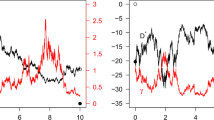Abstract
This work studies the constrained optimal execution problem with a random market depth in the limit order market. Motivated from the real trading activities, our execution model considers the execution bounds and allows the random market depth to be statistically correlated in different periods. Usually, it is difficult to achieve the analytical solution for this class of constrained dynamic decision problem. Thanks to the special structure of this model, by applying the proposed state separation theorem and dynamic programming, we successfully obtain the analytical execution policy. The revealed policy is of feedback nature. Examples are provided to illustrate our solution methods. Simulation results demonstrate the advantages of our model comparing with the classical execution policy.




Similar content being viewed by others
Notes
Note that \(p_k\) is the price before the trading happens at stage k.
By using this model, the filtration \(\mathcal {F}_k\) can be specified as the sigma-algebra generated by the realization of the random variables until time \(k-1\), i.e., the realizations of \(\theta _0,\varepsilon _0\), \(\theta _1, \varepsilon _1, \cdots , \theta _{k-1}, \varepsilon _{k-1}\).
References
Almgren, R., Chriss, N.: Value under liquidation. Risk 12, 61–63 (1999)
Bertsimas, D., Lo, A.W.: Optimal control of execution costs. J. Financ. Mark. 1(1), 1–50 (1998)
Almgren, R., Chriss, N.: Optimal execution of portfolio transactions. J. Risk 3(2), 5–39 (2001)
Almgren, R.: Optimal execution with nonlinear impact functions and trading-enhanced risk. Appl. Math. Finance 10(1), 1–18 (2003)
Almgren, R., Thum, C., Hauptmann, E., Li, E.: Equity market impact. Risk 7, 57–62 (2005)
Chen, J., Feng, L., Peng, J., Ye, Y.: Analytical results and efficient algorithm for optimal portfolio deleveraging with market impact. Oper. Res. 62(1), 195–206 (2014)
Cont, R., Stoikov, S., Talreja, R.: A stochastic model for order book dynamics. Oper. Res. 58(3), 549–563 (2010)
Gould, M.D., Porter, M.A., Williams, S., McDonald, M.D., Fenn, J., Howison, S.D.: Limit order books. Quant. Finance 13(11), 1709–1742 (2013)
Rosu, I.: A dynamic model of the limit order book. Rev. Financ. Stud. 22(11), 4601–4641 (2009)
Obizhaeva, A.A., Wang, J.: Optimal trading strategy and supply/demand dynamics. J. Financ. Mark. 16(1), 1–32 (2013)
Kavajecz, K.A.: A specialists quoted depth and the limit order book. J. Finance 54(2), 747–771 (1999)
Kempf, A., Korn, O.: Market depth and order size. J. Financ. Mark. 2(1), 29–48 (1999)
Ranaldo, A.: Order aggressiveness in limit order book markets. J. Financ. Mark. 7(1), 53–74 (2004)
Alfonsi, A., Fruth, A., Schied, A.: Optimal execution strategies in limit order books with general shape functions. Quant. Finance 10(2), 143–157 (2010)
Tsoukalas, G., Wang, J., Giesecke, K.: Dynamic portfolio execution. Manag. Sci. (2017)
Chen, N.Y., Kou, S., Wang, C.: A partitioning algorithm for markov decision processes and its applications to market microstructure. Manag. Sci. (2017). https://doi.org/10.1287/mnsc.2016.2639
Potters, M., Bouchaud, J.P.: More statistical properties of order books and price impact. Phys. A 324, 133–140 (2003)
Bouchaud, J., Gefen, Y., Potters, M., Wyart, M.: Fluctuations and response in financial markets: the subtle nature of random price changes. Quant. Finance 4(2), 176–190 (2004)
Weber, P., Rosenow, B.: Order book approach to price impact. Quant. Finance 5(4), 357–364 (2005)
Biais, B., Hillion, P., Spatt, C.: An empirical analysis of the limit order book and the order flow in the paris bourse. J. Finance 50(5), 1655–1689 (1995)
Author information
Authors and Affiliations
Corresponding author
Additional information
This paper is dedicated to Professor Duan Li in celebration of his 65th birthday.
This research is partially supported by the National Natural Science Foundation of China (No.61573244).
Rights and permissions
About this article
Cite this article
Wu, WP., Gao, JJ. Explicit Solution for Constrained Optimal Execution Problem with General Correlated Market Depth. J. Oper. Res. Soc. China 6, 159–174 (2018). https://doi.org/10.1007/s40305-018-0197-3
Received:
Revised:
Accepted:
Published:
Issue Date:
DOI: https://doi.org/10.1007/s40305-018-0197-3




